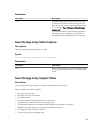
operation, stripe size, and whether replication is enabled may result in less memory being available to
complete the DCE operation. In such a scenario, try each of the options below and retry the operation:
• Create the required disk group size using other unassigned physical disks.
• Delete the current disk group and then recreate the disk group with the desired number of physical
disks.
• Reduce the segment size being used and then retry the operation.
Set Disk Group Forced State
Description
This command moves a disk group into a Forced state. Use this command if the start diskGroup
import command does not move the disk group to an Imported state or if the import operation does
not work because of hardware errors. In a Forced state, the disk group can be imported, and you can
then identify the hardware errors.
Syntax
set diskGroup [diskGroupName] forcedState
Parameters
Parameter Description
diskGroup
Sequence number of the disk group for which to
set properties. You must put brackets ([ ]) around
the disk group number.
NOTE: You can move the physical disks that comprise a disk group from one storage array to
another storage array. The CLI provides three commands that let you move the physical disks. The
commands are start diskGroup export, start diskGroup import, and set diskGroup
forcedState. In the Forced state, you can perform an import operation on the disk group.
Set Disk Pool
Description
This command sets the attributes associated with a disk pool based on the specified parameters.
Syntax
set (diskPool [diskPoolName] | diskPools [diskPoolName1... diskPoolNamen] |
allDiskPools) [reservedPhysicalDiskCount=
reservedPhysicalDiskCountValue]
[warningThreshold=(warningThresholdValue | default)]
[criticalThreshold=(criticalThresholdValue | default)]
[criticalPriority=(highest | high | medium |low |lowest)]
[degradedPriority=(highest |high |medium |low |lowest)]
[backgroundPriority=(highest | high | medium |low |lowest)]
[userLabel=diskPoolName]
288


















